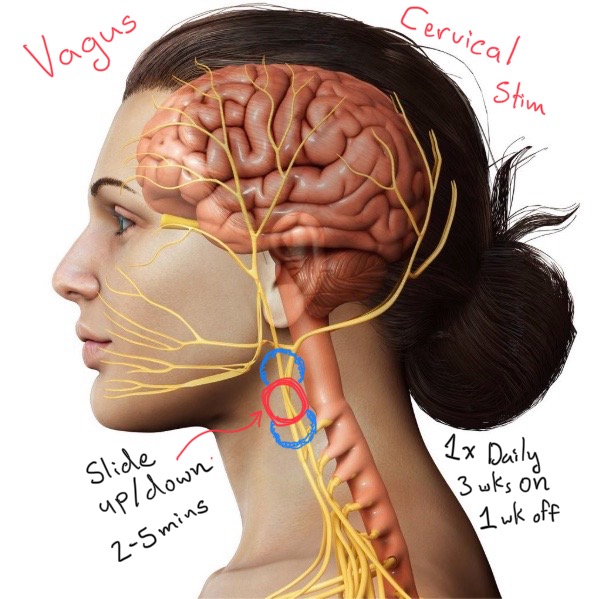Activity
Mon
Wed
Fri
Sun
Oct
Nov
Dec
Jan
Feb
Mar
Apr
May
Jun
Jul
Aug
Sep
What is this?
Less
More
Memberships
VS
Vagus School
406 members • Free
3 contributions to Vagus School
US2000 vs US1000
Is the low setting on the US2000 equivalent to medium setting on the US1000? 🤔
2 likes • 26d
The power output of the US-2000 low setting is quite close to the US-1000 medium setting. However the US-2000 operates at 100Hz repetition rate, rather than the US-1000's 150Hz. And their duty cycles are different as well, the US-2000 can operate in pulsed or continuous mode, whereas the US-1000 only operates in pulsed mode afaik. From my understanding the US-1000 beam pattern may be dispersed over a wider area, whereas the collimated beam of the US-2000 may be more focused. More details can be found in this thread: https://www.skool.com/vagus/us-1000-vs-us-2000-power-specifications
US-1000 vs US-2000 Power Specifications
Ok, so awhile back there was some discussion about safety regarding using the US-1000 / US-2000 devices for transcranial treatment on twitter / X. I think this may have arisen due to lack of accurate data on the power levels of these devices listed specs. I ordered my US-1000 from Tenspros. When I look at their listings, there is possibly some inaccurate power specs for the US-1000 IMO. I would like to get some feedback / clarification on this if possible. US-1000 Specs from tenspros: Product Specifications: - Power Source: AC Adapter - 100-240 Volts AC Input (DC 15V) - Frequency: 1.0 MHz ± 10% - ERA Treatment Area: 6.16 cm² ± 20% - Temporal Maximum Power: 4W ± 20% - Output Mode: Pulse - Output Intensity: 1.6W/cm² (Low), 2.6W/cm² (Medium), 4.6W/cm² (High) - Duty Cycle: 8% (Low), 14% (Medium), 29% (High) - Pulse Width:Low: 8% 0.5mS ± 10%Medium: 14% 1mS ± 10%High: 29% 2mS ± 10% - Repetition Rate: 150Hz ± 10% - Working Time: 30 Minutes - Material of Applicator: Aluminum - Beam Type: Collimated US-2000 Specs from tenspros: Product Specifications: - Ultrasound Modulation/Acoustic Frequency: 1.0 MHz ±10% - Temporal Maximum Output Power: 6.4W ± 20% (Modulation duty cycle at 100%) - Output Power:(L) 0.32W ± 20%(M) 3.20W ± 20%(H) 6.40W ± 20% - Pulse Repetition Rate: 100Hz ± 10% - Modulation Duty Cycle (Duty Factor): (L) 5%, (M) 50%, (H) 100% - Effective Radiating Area (ERA): 4.0 cm² ± 20% - Beam Non-uniformity Ratio (BNR): 5.0 max - Max. Effective Intensity: 1.6 W/cm² ± 20% (Modulation duty cycle at 100%) - Effective Intensity:(L) 0.08 W/cm² ± 20%(M) 0.80 W/cm² ± 20%(H) 1.60 W/cm² ± 20% - Treatment Time: 5, 10, or 15 minutes - Preheat Time: 3-5 minutes - Wave Form: Pulsed or Continuous - Dimensions: 7.95" L x 1.93" W x 2.76" H (202 x 49 x 70mm) - Weight: 0.43 lbs (193g) (without adapter) - Material of Applicator: Aluminum - Beam Type: Collimated There seems to be a discrepancy in the Output intensity for the US-1000, whereas the US-2000 listings seem accurate, IMO. The US-1000 peak power output is lower, yet it's low, medium output power is listed as follows:
2 likes • Aug 24
@Mark B Thanks. For some reason it failed to occur to me to search for a .pdf of the manual. Thanks to your post I searched and found it easily, I agree with your calculations. Looks like all the levels for the US-1000 should be well within safe range IMHO. I will attach the .pdf for anyone who's interested. https://www.tenspros.com/assets/images/manuals/us-1000-ultrasound-therapy-device-du1025-instruction-manual.pdf
Overview of Methods of Ultrasound Stimulation of Vital Vagus Centers
Hell all ! Whew! the group is expanding faster than I envisioned ! I want to provide a "Full Scope" view of what you *can* do with the Vagus Nerve Stimulation Tech we have available (Once you get to LVL 2) but - which, if you read this post, will be able to see right here on the wall. 1) Vagus Nerve Cervical Stimulation with Ultrasound: You will be placing the Ultrasound on the left side of the neck - 2-5 Mins is good - Start Low and Work Way Up - Shouldn't Feel Anything from Ultrasound Itself - but effects can be very calming if used before bed, assisting in Sleep, and improving HRV. 2) Spleen Stimulation with Ultrasound: A relatively difficult spot to stimulate, get help if possible. But can definitely be done yourself too. Going to want 5 mins on Medium to High intensity, due to likelihood of imperfect placement, and it's going to be "peering" through rib cage window slits. Excellent for helping your body control inflammation globally. 3) Cerebral Ultrasound - Insular Cortex Stimulation: This targets a region of the brain that deals with your bodies memory of previous inflammatory responses. Thus, stimulation of this region increases brain neuroplasticity, and enables you to "move on" from previous cyclical inflammatory responses. (People associate emotional "pain" with an inflammation response - thus a painful memory (trigger) (trauma even) can produce an identical inflammatory spike throughout the body) - The Insular Cortex is where this happens. Highly supportive of Spleen Stimulation protocol. 4) Other uses have been explored for Lymphatic Drainage, but this is on a case by case basis, and typically utilized best when/if the body has some major lymphatic drainage issue (water retention / lymph swelling in specific parts of the body [such as left side of body near armpits] that may benefit from increased lymphatic drainage activity) - Ultrasound amplifies Lymphatic systems (also glymphatic brain cleaning is activated as well) - and is generally utilized for 5 minutes on Medium to High settings, as is comfortable on the body - and likely for 1-2 weeks until swelling has subsided.

1-3 of 3
Online now
Joined Jul 8, 2025
Powered by



